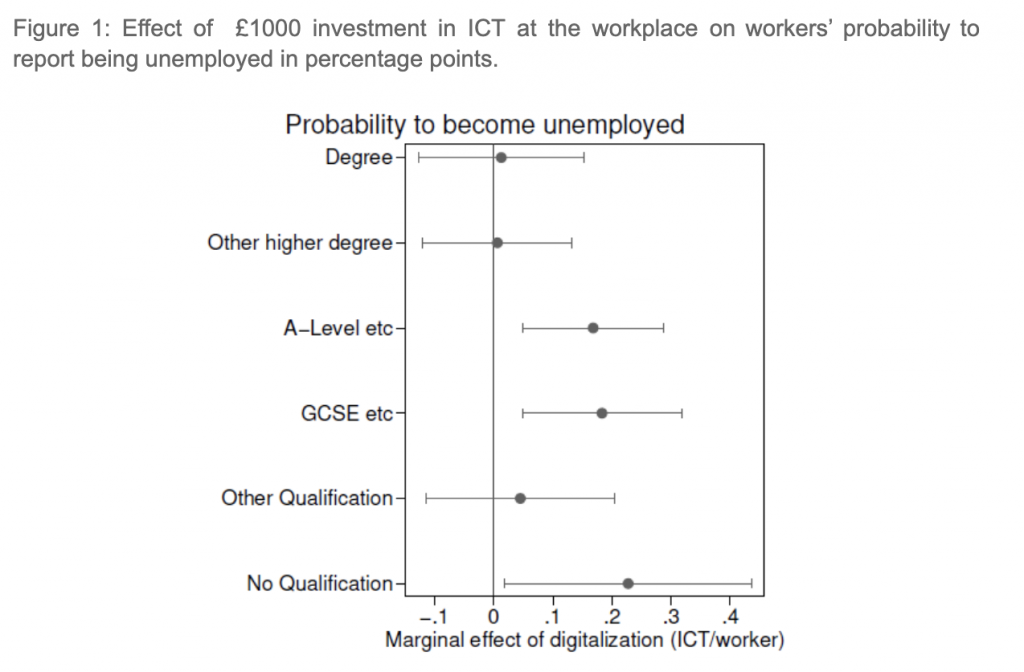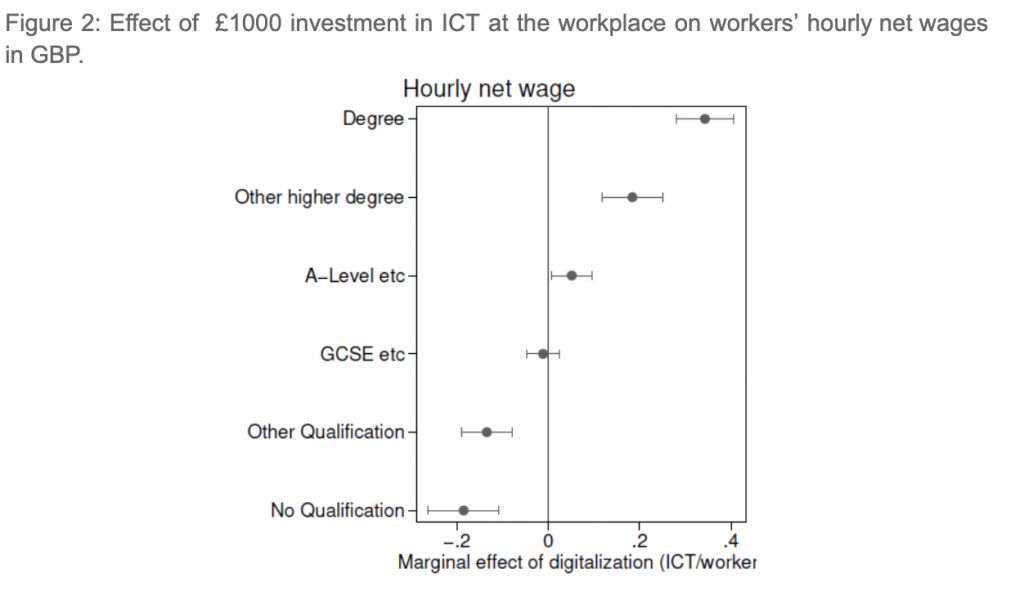 While there are few signs that workplace digitalisation leads to mass unemployment, Nikolas Schöll finds that it contributes to growing income inequalities between low and highly educated workers. These diverging economic trajectories are also mirrored in party support: winners of digitalization become more supportive of the incumbent government and the Conservative Party, whereas losers of digitalization become tentatively more supportive of UKIP.
While there are few signs that workplace digitalisation leads to mass unemployment, Nikolas Schöll finds that it contributes to growing income inequalities between low and highly educated workers. These diverging economic trajectories are also mirrored in party support: winners of digitalization become more supportive of the incumbent government and the Conservative Party, whereas losers of digitalization become tentatively more supportive of UKIP.
The COVID-19 pandemic has pushed workplace digitalization as few events did before: almost half the UK workforce reports to have worked from home during lockdowns, twice the number of pre-pandemic times. This has boosted the adoption of digital tools, especially in professional and managerial roles. Yet this push towards digitalizing workplaces is part of a longer term transformation. Workplace digitalization started in the 1980s with the adoption of PCs, gained strength with the roll-out of the internet around 2000, and so far culminated in the introduction of artificial intelligence algorithms.
To find out how digitalization affects employment prospects and wages, we used a representative sample of 60,000 British workers from the Understanding Society survey and followed their career trajectories between 1997 and 2017. We infer how much a given worker is affected by digitalization in a given year by using investments in information and communication technology (ICT) in their respective industry.
Since we observe workers across time and industries, we can focus on within-individual changes, abstracting from factors that are constant for a given worker (e.g. their inherent ability) and factors related to specific years (e.g. the evolution of the economy). Technically, this is called a two-way fixed effect panel model.
In a nutshell, we find that digitalization increased unemployment risks only marginally. Figure 1 shows that only workers with a middle or lower education level are affected. Their probability to report being unemployed increases by 0.2 percentage points if their workplace digitalizes, i.e. receives a per-worker investment in ICT of £1000. While these effects are significant, they do not suggest that we are at the brink of technological mass unemployment (the UK unemployment rate is currently at 4.2%).
More alarming is the finding that digitalization leads to strong wage polarization. Figure 2 shows that highly educated workers receive higher wages when their workplace digitalizes. For example, workers with a university degree earn on average £0.40 more in hourly wages if their workplace digitalizes. These +£0.40 might seem small, but accumulated over a year, amount to +£700.
While workers with other higher degrees (foundation degrees, apprenticeships) also gain when their workplace digitalizes, the picture turns more and more bleak for workers of lower education levels. Workers without a formal education are particularly and negatively affected by workplace digitalization. For them, a £1000 investment in workplace digitalization leads on average to a £0.20 reduction in hourly wages. Over one year, this accumulates to a minus of about -£350. Digitalization therefore has limited effects on employment prospects but displays a strong wage polarizing patterns.
What explains these patterns?
The leading paradigm of understanding how technological change affects labour markets is to conceptualize it as routine biased. Routine bias means that new technologies take over routine tasks that can be accomplished by following explicit rules. Creative, interactive, and non-routine analytical tasks are much harder to automate. Typical examples of routine biassed automation is the replacement of bank tellers by ATMs and online banking, or the substitution of supermarket cashiers with self-checkouts.
Following this argument, both Karl Marx and Maynard Keynes at times (wrongly) predicted that work available to humans would mostly disappear. What invalidated their prediction is the fact that new technologies also create new tasks and jobs complementary to these technologies (e.g. software developer or web designer are complementary to computers and the internet). As we have seen, the overall employment effects are rather limited, and a jobless future is not in sight.
However, focusing on these averages mask an important feature of technological change. While some societal groups mainly face the downsides of technological change as their jobs have a high risk of automation, others benefit from it as their skills are complementary to new technologies. As it turns out, tasks performed by workers with a low or medium level of education are most susceptible to automation (remember the example of supermarket cashiers or bank tellers). This is reflected in our results, as these are the ones who face higher unemployment risks and wage cuts when exposed to automation. On the other hand, highly educated workers tend to engage in tasks complementary with new technologies (e.g. software developers or web designers, but also managerial positions).
Furthermore, university education usually facilitates retraining, as it provides the meta-skill of more easily acquiring new skills. In that sense, it might be easier for a librarian (who is also at a high risk of automation) to retrain to become a software developer, compared to a supermarket cashier.
Do affected workers change their voting behaviour?
As a final step, we analysed the self-reported party preferences of those affected by digitalization and compared them to workers of similar characteristics but less affected by digitalization. We found that economic winners of digitalization were more likely to support the Conservatives and the incumbent government. On the other hand, losers of digitalization became tentatively more supportive of UKIP (Figure 3).
Nevertheless, we focus on year-to-year changes of party preferences of a given individual whose workplace digitalized, relative to others with comparable educational degrees whose workplace did not digitalize. This means that we cannot extrapolate that digitalization primarily benefits conservative parties. UKIP was only included as a response option since 2013 and hence data is limited. This leaves us with some uncertainty about true effect sizes and even if we accept this uncertainty, the small size of the no qualification group (only 4% of the sample) makes it clear that it takes a more holistic approach to explain the UKIP’s overall electoral success in that time period.
In a nutshell, the winners of digitalization engage in classical economic voting (those who are doing well economically support more the party in power) and spatial voting (getting richer makes people more economically conservative). On the other hand, those threatened by new technologies become more supportive of right-authoritarian and nativist parties as a response to ‘feeling left behind’.
___________________
The above draws on the author’s published work (with Aina Gallego and Thomas Kurer) in The Journal of Politics. Open-access pre-print version here.
 Nikolas Schöll holds a PhD from Universitat Pompeu Fabra and has been a visiting researcher at the LSE. He is affiliated with the Institute for Political Economy and Governance and the Barcelona School of Economics.
Nikolas Schöll holds a PhD from Universitat Pompeu Fabra and has been a visiting researcher at the LSE. He is affiliated with the Institute for Political Economy and Governance and the Barcelona School of Economics.










